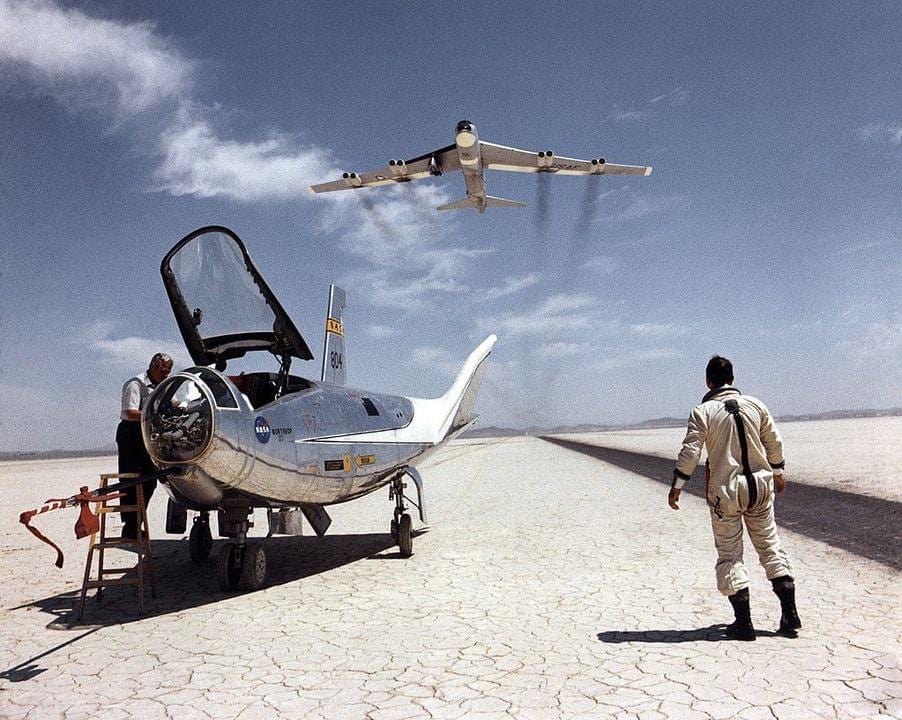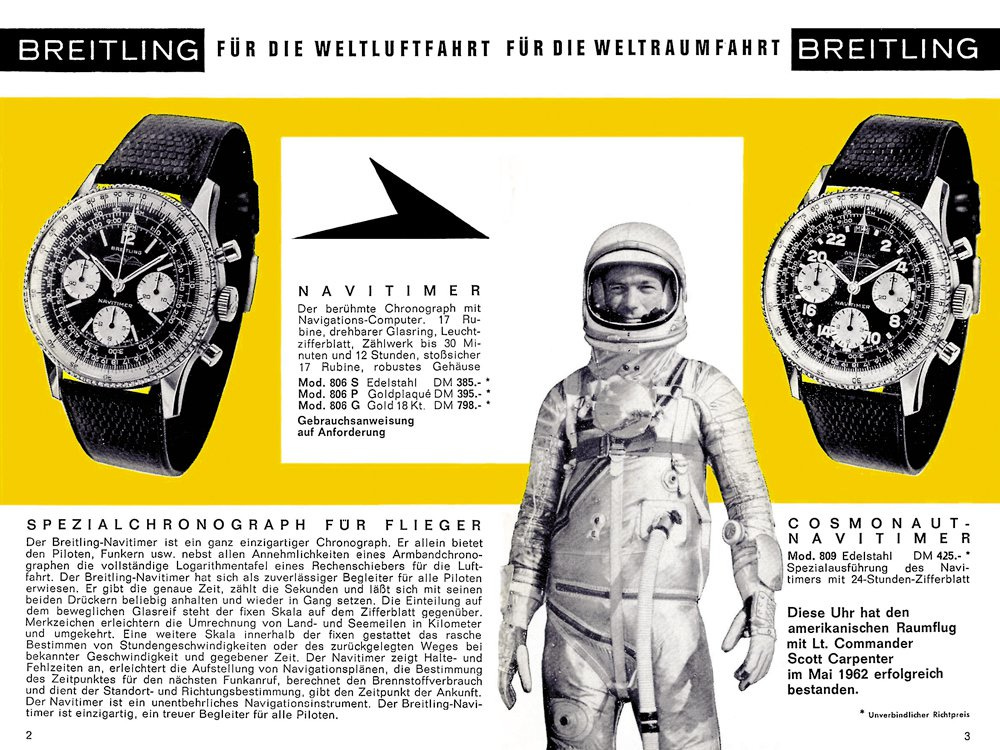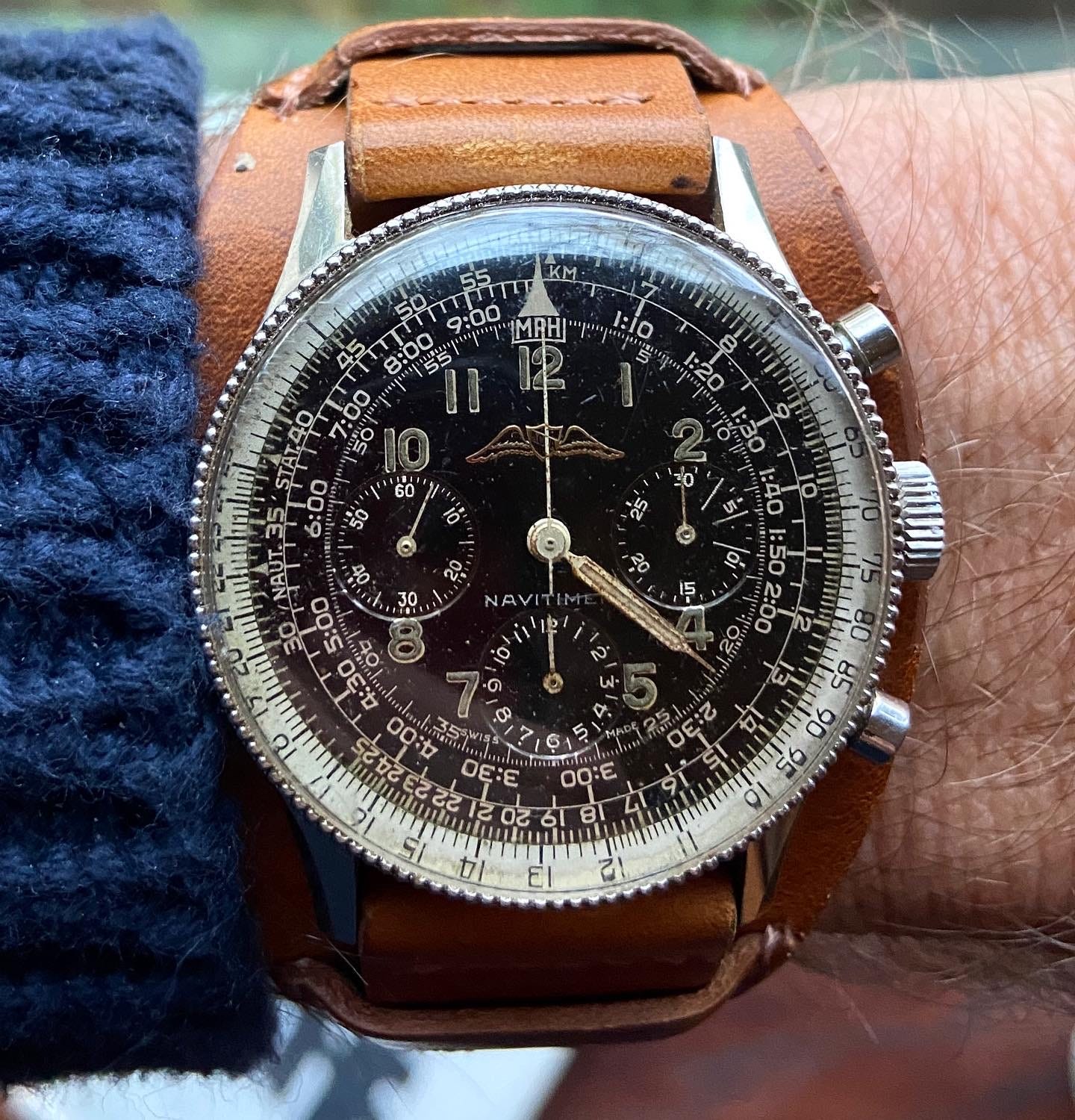Touching the Face of God
Finding immortality in a 70-year old thrift store Breitling
“The wristwatches had about two thousand calibrations on them and dials for recording everything short of the sound of enemy guns. These terrific wristwatches were practically fraternal insignia among the pilots.” –Tom Wolfe, The Right Stuff
Delta Airlines tells me I’ve logged 769,837 miles on their airplanes over the past couple of decades. I’ve also flown plenty of miles on other airlines, in a handful of helicopters in the Alps, Iceland, and New Zealand, a seaplane in the Maldives, and ridden shotgun in two fighter jets during the salad days of my watch journalism career. But my only experience actually flying was during a short flight over the Rockies in a Cessna 172. Back in the 1990s, a friend who is a bush pilot (and erstwhile marriage officiant—she married Gishani and me in Alaska 20 years ago) took me up in her plane out of Jefferson County airport in Colorado for a spin over the flanks of Longs Peak. It was a sort of reconnaissance for my later climb of that mountain. As we rounded back towards the airfield, she asked if I’d like to take the controls for a while, explaining how pitch, yaw, and roll work, controlled by the yoke and pedals. The mechanics took a little getting used to, and the buffeting thermals coming off those mountains were a little unsettling, but I’d say I did alright. Well enough to justify wearing a pilot’s watch? Probably not.
I’ve worn a few so-called pilot’s watches over the years and have even owned a few—an IWC chronograph, a Glycine Airman, a few Bremonts, a Rolex GMT-Master—but they never really stuck around. After all, my preferred environment is under the waves, not up in the clouds, and my watch choices have followed suit, with ample water resistance, often a rubber strap, and some sort of elapsed time ring. There’s also that niggling idea that wearing an instrument so purpose-built is too close to cosplay for me, akin to trick-or-treating in a bomber jacket and aviator glasses. You might recall my “origin story” of learning to scuba dive because I didn’t want to wear my Seamaster without actually diving. Well, I still don’t have a pilot’s license. Still, I can’t deny a long interest in aviation, the Jet Age, the Cold War, and the space race. It’s been an armchair pursuit of mine for many years and, as a watch enthusiast, it’s impossible to ignore the legacy of some amazing pilot’s watches intertwined with all that history of flight.
I write all that as a sort of preamble. You see, as I am typing this, on my wrist is perhaps the most storied of all pilot’s watches: a Breitling Navitimer. And it’s not just any Navitimer. This one is from 1954, the first year of the watch’s production, distinguished by its 125-bead rotating bezel (in reality, the entire crystal rotates with it), its all-black gilt dial featuring the winged logo of the Aircraft Owners and Pilots Association (AOPA), and housing a hand-wound Valjoux 72 calibre inside. This is the “ur-Navitimer,” an archetype upon which so many watches were based, and when it was released in the mid-50s, it became a symbol of fighter jock/test pilot swagger and derring-do. If you were rocking up to Muroc Air Force Base in the high desert of California to push the envelope of the latest supersonic jet in the late ‘50s, odds are, this watch was on your wrist. So what is doing on mine as I’m flying a MacBook (Air!) here in Minneapolis? That is a pretty remarkable story in its own right.
I got a message from a good friend a couple months ago, asking to weigh in on a wristwatch her friend stumbled upon at a thrift store. A photo accompanied the message, showing the watch you see here. I just about spat out whatever I was quaffing at the moment. I’ve seen my share of Navitimers, some old ones, and many more modern iterations. And I immediately knew this was an early version. After the first couple of years, Breitling changed the watch, going to a milled-edge bezel and white dial counters for better legibility. So the beaded edge of this bezel told me it had to be from the 1950s. To get more exact would require levering off the caseback to check the movement and the serial number inside. I only got that chance this week, after a road trip south.
To be clear, I am currently only the custodian of this watch, entrusted with it in order to discover its condition and its value. The actual owner is, by his own admission, not a watch enthusiast. He did, however, recognize that this timepiece, sitting in a bag of bargain trinkets on the counter of this thrift store, was something special. It had a weight to it, a glint of value, a purposefulness to its design, and the aura of timelessness and craftsmanship that is so lacking in so much modern ephemera. He snatched it up, along with its companion, a pair of gold-framed Ray-Ban sunglasses. His investment in these unknown entities was not exactly high risk. He paid the princely sum of… 50 cents. To be fair, the sunglasses cost the same, so this friend was out one US dollar.
Further research into the watch revealed some clues as to its provenance. Keep in mind, this thrift store is in a fairly small town, so following the threads of evidence was not terribly difficult. The shop was something of a clearing house for people’s castoff household goods, old clothes, furniture, books, and odds and ends. It often becomes the way station for a deceased family member’s items after the funeral is done and the will is read. This seems to be the case with this old Breitling. An obituary in the local paper from a few weeks prior told the story of a 90-year old man who died after a “bruising struggle with dementia.” It’s an all too common sad ending, and in the case of this poor soul, particularly so. The life he led was one of great accomplishment, ambition, service, and adventure. Out of respect to the man, and his family, I won’t give his name, but he was the grandson of Scandinavian immigrants who grew up on a farm, and then went on to join the Air Force, where he rose to the rank of Captain. He was trained for both fixed-wing and helicopter flying. He served in the Air Force, both active service and as a reserve, until the early 1970s, then went on to get a PhD and become a professor. He continued to fly as a private pilot, taking his family on trips around the US. He was a vibrant, active man, full of curiosity and bravery. People in the Midwest are generally not known for their ostentatious displays of wealth, but while Breitling may be a luxury brand these days, to wear a Navitimer in the mid-1950s would have been perfectly in keeping with its owner’s pragmatic ethos. It was, no doubt, a tool for a pilot, but perhaps also a symbol, that “fraternal insignia,” Tom Wolfe described in The Right Stuff.
This particular Navitimer was shod with a stiff, plastic Tropic strap. Most common on the dive watches of the era, it is a bit of an odd choice for this most quintessential of pilot’s watches, especially one with virtually no water resistance. Yet the strap choice is a hint as to the ethos of the man who owned and wore this watch for many years. It would have held up better against sweat than leather and perhaps a bit more durable. I have since moved the watch on to a more aesthetically pleasing, if a bit predictable, choice: a leather “bund” strap, and it looks magnificent. Cognizant of the taboo against altering anything from the watch’s original state, I have done nothing to it beyond cleaning some of the former owner’s DNA from the case when I swapped the strap, and polishing the scratches from its acrylic crystal, to reveal the gorgeous dial. I also carefully prised off the caseback to check its serial number and confirm the movement. Inside I found a very clean and well running column-wheel chronograph movement, the vaunted Valjoux 72, the same calibre found in so many famous watches of the era, most notably the Rolex Daytona of the following decade. The inside of the caseback had a prominently marked serial number that confirms its year of manufacture as 1954, the very first year of production. Some etched watchmakers’ markings show that it was opened up in 1955 for some reason, and twice in 1967, then never again.
Did its original owner stop wearing it in the late ‘60s? He left the Air Force in 1970, and by that time the Breitling would have been 16 years old, a considerable run for any watch. Clearly it had been well maintained, but perhaps life changed and he no longer needed a slide rule on his wrist, or a chronograph. Maybe he wanted something he could wear snorkeling. And by that time, not only were self-winding chronographs available, but so were battery powered quartz watches. The old Navitimer was a relic by the early ‘70s. Maybe he wound it one last time and slid it into a desk drawer, only to be unearthed a few months ago when his family was sorting through a household of earthly possessions.
Amazingly, for all my years in the watch industry, I’ve never had a Navitimer on my wrist. Now I’ve been wearing this one for several days straight and it is a revelation. I have always admired these watches from afar. They are truly one of the top five most recognizable and iconic “tool” watches of all time. But my aforementioned affection for dive watches kept me away. The closest I came to anything similar was my vintage Speedmaster, an equally hydrophobic but similarly legendary chronograph. This is something else entirely. For its age, the 40 millimeter case and 22 millimeter strap width wears remarkably modern and its proportions are perfect. The beaded bezel grip seems oddly decorative on such a utilitarian watch. The trademark feature, of course, is the slide rule. It is altogether illegible, even more so with my aging eyes (maybe another reason its original owner finally retired it), but even if I could read its markings, they remain entirely inscrutable. Believe me, I have tried to figure out how to use a circular slide rule, even asking a Breitling rep for any historical guidance, but it remains a mystery. But all those tiny numbers, peppered as they are in a bloom of gilt printing on a glossy dial speak of a bygone, analog era and an earnestness that is absent in so many products nowadays. To imagine a pilot, in a shaking, snug cockpit, calculating his remaining fuel, using this tiny tool, is as impressive as envisioning a diver using an Aquastar Deepstar to compute his no-decompression time on repetitive dives. Clearly, our glass cockpits and dive computers have made us soft.
Driving north, with the Navitimer on my wrist last weekend, I activated the chronograph with a click, and immediately felt an electricity from this simple act. When was the last time it was used to time something, and where? The dial had been looked on countless times by the same pair of eyes until it wasn’t anymore, and now it is rediscovered, resurrected, to be used again.
It will come as no surprise, but I like old things, whether a 50-year old Land Rover in the garage, the century-old clock above my fireplace, or a watch on my wrist. These things are indifferent to me. They will serve any master that will care for them, as they did faithfully for many years before I came along, and they likely will long after I am gone. I don’t necessarily collect vintage things as a habit or with any strategy, but there’s something warming, reassuring, and yes, a little bit melancholy about having them around and using them. The world from which they came is no more, in some cases for the better, but often for the worse. Knowing just a little about this Breitling’s original owner and winding it up and wearing it lends the familiar feeling I have gotten driving the Land Rover or diving with that old Doxa I had restored a few years ago. There is so much mystery embedded in them—of adventures, triumphs, tragedies, and mishaps—that may be lost to the mists of time, and yet these possessions, these tools, these mementoes go on and on in a sort of reincarnation. It is as close to immortality as we might ever get.







I have always loved vintage stuff and never really understood why, until now. Well written and what a cool thrift store catch!
A beautiful, elegiac post.